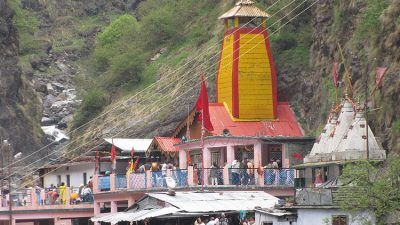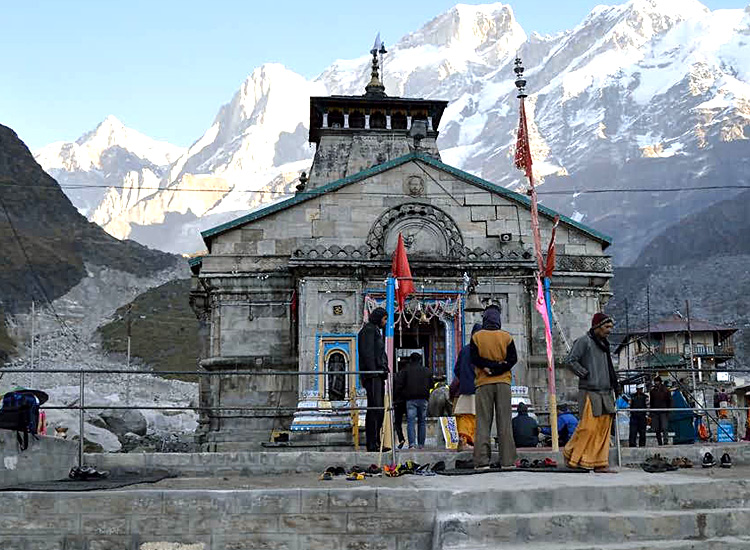The Char Dham Yatra of Uttarakhand is considered to be one of the most important pilgrimage circuits. According to Hindus, Char Dham Yatra is the absolute path of spiritual cleansing and salvation. The holy yatra comprises of four sites, namely Yamunotri, Gangotri, Kedarnath and Badrinath. Each of these sacred destination has associated with mythology and legends has its own importance for religious purposes.
The great Hindu spiritual leader, Adi Shankaracharya had initiated this Yatra during 8th century, for the revival of Hindu religion. According to vedic rituals, Char Dham Yatra is embarked upon from the West to the East, therefore, the trek begins from Yamunotri, continuing to Gangotri, then Kedarnath and finally Badrinath.
The article offers you detailed information on the four destinations of Char Dham Yatra in Uttarakhand:
Yamunotri

Yamunotri is the starting point of the Char Dham Yatra. The Yamunotri Temple to the Goddess Yamuna. Though the source of River Yamuna, the Yamunotri glacier is located close to the Bandar Punch peaks (at a height of 20,955 ft. above sea level), the main shrine is nestled within the Garhwal Himalayas.
According to Hindu mythology, this place was home of Sage Asit Muni who led a pious life and was blessed by the river Goddesses Ganga and Yamuna. It is believed by pilgrims that by taking a dip in the river one can avoid a painful death as Yamuna is the daughter of the Sun God and the twin sister of the Lord of Death, Yama. Pilgrimage to this site is said to cleanse sins of a lifetime.
Pilgrims visiting the scared site Yamunotri, first visit the hot water spring in Suraj Kund. Here devotees prepare potatoes and rice, which is also taken back home in the form of Prasad. Divya Shila, close to Janki Chatti is also worshipped, after which pilgrims visit the main temple of Yamunotri.
Gangotri

The second destination of the Char Dham Yatra is Gangotri. Located at a height of 3100 meters in the Greater Himalayan Range, this popular religious site is settled along the banks of the holy River Ganga. A dip in this holy river can wash away all your sins. The original source of the river is amidst the Gangotri Glacier, called Gaumukh. A trek of 19 km from the shrine will take you to the glacier.
According to the legends, Goddess Ganga had taken the form of a river to wash away the sins of generations of King Bhagirathi, after his severe penance for several centuries. Lord Shiva had opened his tangled hair to capture the flow of unrestricted Ganga.
Pilgrims not only pray at the main temple of Gangotri but also to the Bhavishya Badri temple. This temple houses an idol of Narsingha, an incarnation of Lord Vishnu with the head of a lion. Legends say that the route to the main Badrinath will become inaccessible for humans, and Badrinath will be worshipped in this place only.
Kedarnath

The third location of the Char Dham Yatra is Kedarnath. Kedarnath houses the well-known Kedarnath temple, devoted to Lord Shiva. It is also one of 12 Jyotirlingas in India. Located in Uttarakhand at an altitude of 3584 m in the Garhwal Himalayas along the River Mandakini, it is one of the most revered holy sites of the devotees of Hindu religion. Pilgrims come here to attain salvation from the circle of life.
Mythical legends say that the temple is associated with story of the Mahabharata war. After the Kurukshetra war, Pandavas wanted to seek Lord Shiva’s blessings for redemption as they had killed their own blood. Lord Shiva disguised himself as a bull, and hid himself in the ground with his hump being visible. The hump became the Swayambhu lingam and became the sacred site of Kedarnath. Kedarnath along with Rudranath, Tungnath, Madmaheshwar and Kapleshwar is called Panch Kedar, one of the religious pilgrimage for Shivaites, believers of Lord Shiva.
Badrinath
Badrinath, the fourth and the last destination of Chota Char Dham Yatra is one of the most revered sites in India. Dedicated to Lord Vishnu in his form of Badri, this shrine is situated in Chamoli District, Uttarakhand, nestled between the Nar and Narayan ranges.
Badrinath temple is mentioned in the ancient Vedic scriptures and was the prime religious site revived by Hindu Spiritual leader Adi Shankaracharya. The word Badrinath is a formation of two words Badri + Nath. Badri means berry and Nath means lord. In Badrinath, Jujube trees can be found in abundance.
According to mythology, this was the place where Lord Vishnu, in the incarnation of Nar and Narayan sages, had meditated for thousands of years. At that time Lakshmi ji, in the form of Berry had sheltered him from the harsh weather, and so the name Badrinath.
The Badrinath temple, is dedicated to Lord Vishnu. The main idol in the temple is made up of black Saligram stone. Along with the main Badrinath temple, other places of interest are Tapt Kund, Neelkantha temple, Hemkund Sahib and Mata Murthi temple.
Along with Badrinath temple, Yogdhyan Badri, Bhavishya Badri, Adi Badri and Bridha Badri make Panch Badri. It is one of the holiest pilgrimage circuit for Vaishnavites in India.
If You Are Looking For This Holy Journey !! Then We Will Provide You Complete Solution For Your Char Dham Yatra 2022.
